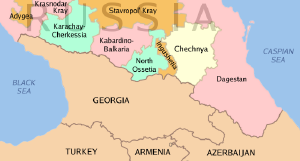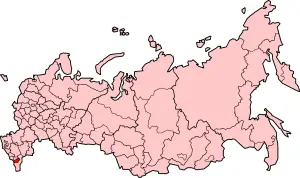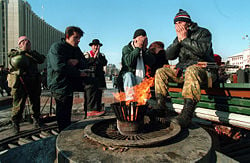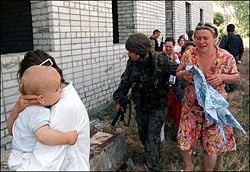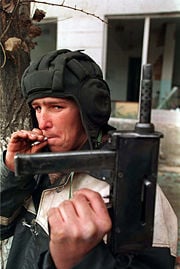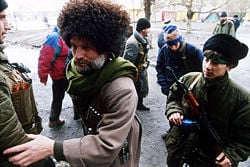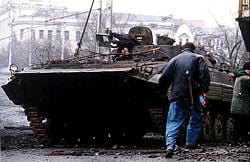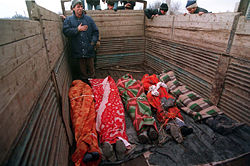First Chechen War
| First Chechen War | |||||||||
|---|---|---|---|---|---|---|---|---|---|
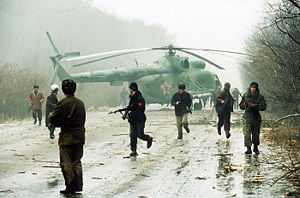 Russian Mil Mi-8 helicopter downed by Chechen rebels near Grozny, December 1994 | |||||||||
| |||||||||
| Combatants | |||||||||
Russian Federation |
Chechen Republic of Ichkeria | ||||||||
| Commanders | |||||||||
| Pavel Grachev Anatoly Kulikov Konstantin Pulikovsky Anatoliy Romanov Anatoly Shkirko Vyacheslav Tikhomirov Gennady Troshev |
Dzhokhar Dudayev Aslan Maskhadov | ||||||||
| Strength | |||||||||
| 38,000 (December 1994) 70,500 (February 1995) |
15,000[1] | ||||||||
| Casualties | |||||||||
| Military: 5,500 (official Russian figure); 14,000 (SMR estimate).[2] Civilian: At least 161 killed outside Chechnya[3] |
Military: At least 10,000 killed or missing Civilian: 50,000–100,000 dead[4] | ||||||||
Template:Campaignbox First Chechen WarTemplate:Campaignbox Post-Soviet Conflicts
The First Chechen War also known as the War in Chechnya was fought between Russia and Chechnya from 1994 to 1996 and resulted in Chechnya's de facto independence from Russia as the Chechen Republic of Ichkeria.
After the initial campaign of 1994–1995, culminating in the devastating Battle of Grozny, Russian federal forces attempted to control the mountainous area of Chechnya but were set back by Chechen guerrilla warfare and raids on the flatlands in spite of Russia's overwhelming manpower, weaponry, and air support. The resulting widespread demoralization of federal forces, and the almost universal opposition of the Russian public to the brutal conflict, led Boris Yeltsin's government to declare a ceasefire in 1996 and sign a peace treaty a year later.
The official figure for Russian military losses is 5,500, while most estimates put the number between 3,500 and 7,500, one as high as 14,000.[5] Although there are no accurate figures for the number of Chechen militants killed, the official Russian estimate puts the number at about 15,000. Chechen separatists claim no more than 3,000. Various figures estimate the number of civilian deaths between 50,000 - 100,000, and over 200,000 injured. More than 500,000 persons were displaced by the conflict,[6] as cities and villages across the republic were left in ruins.
Origins of the war in Chechnya
Imperial Russia and the Soviet Union
Cossacks had lived in lowland Chechnya (Terek) since the 16th century. Russia first invaded the Chechen highlands during the reign of Catherine the Great, in the early 18th century. After a series of fierce battles, Russia defeated Chechnya and annexed it in the 1870s. Chechnya's subsequent attempts at gaining independence after the fall of the Russian Empire failed. In 1922 Chechnya was incorporated into Bolshevist Russia and later into the Soviet Union (USSR). Leo Tolstoy was stationed in Chechnya, where he set his novel Hadji Murat about the "pacification" process, which he depicted as immoral, describing Russian atrocities against the Chechens, ending with one character asking whether, since Russians had "dispensed with the laws of war, were they in fact nothing more than bandits.[7] The population of the region was reduced by half as a result of the campaigns of the nineteenth century.
In 1936, Soviet leader Joseph Stalin created the Chechen-Ingush Autonomous Soviet Socialist Republic. In 1944, on the orders of NKVD chief Lavrenti Beria, more than 1 million Chechens, Ingushes, and other North Caucasian peoples were deported to Siberia and Central Asia, officially as punishment for alleged collaboration with the invading Nazi Germany. Stalin's policy made the state of Chechnya a non-entity. Eventually, Soviet first secretary Nikita Khrushchev granted the Chechen and Ingush peoples permission to return to their homeland and restored the republic in 1957.
The collapse of the Soviet Union
Russia became an independent nation after the collapse of the Soviet Union in December 1991. While Russia was widely accepted as the successor state to the USSR, it lost most of its military and economic power. While ethnic Russians made up more than 70% of the population of the Russian Soviet Federated Socialist Republic, significant ethnic and religious differences posed a threat of political disintegration in some regions. In the Soviet period, some of Russia's approximately 100 nationalities were granted ethnic enclaves that had various formal federal rights attached. Relations of these entities with the federal government and demands for autonomy erupted into a major political issue in the early 1990s. While such former satellite republics as Georgia, Ukraine, Azerbaijan and Armenia among others became sovereign, independent states, Russia was reluctant to see its size diminish even more. In the case of Chechnya, Russia did not wish to lose control.
President Yeltsin incorporated these demands into his 1990 election campaign by claiming that their resolution was a high priority. There was an urgent need for a law to clearly define the powers of each federal subject. Such a law was passed on March 31, 1992, when Yeltsin and Ruslan Khasbulatov, then chairman of the Russian Supreme Soviet and an ethnic Chechen himself, signed the Federation Treaty bilaterally with 86 out of 88 federal subjects. In almost all cases, demands for greater autonomy or independence were satisfied by concessions of regional autonomy and tax privileges. The treaty outlined three basic types of federal subjects and the powers that were reserved for local and federal government.
The only federal subjects which did not sign the treaty were Chechnya and Tatarstan. Eventually, in the spring of 1994, President Yeltsin signed a special political accord with Mintimer Şäymiev, the president of Tatarstan, granting many of its demands for greater autonomy for the republic within Russia. Thus, Chechnya remained the only federal subject which did not sign the treaty. Neither Yeltsin nor the Chechen government attempted any serious negotiations and the situation would deteriorate into a full-scale conflict.
Chechen declaration of independence
Meanwhile, on September 6, 1991, militants of the All-National Congress of the Chechen People (NCChP) party, created by former Soviet general Dzhokhar Dudayev, stormed a session of the Chechen-Ingush ASSR Supreme Soviet with the aim of asserting independence. They killed the Communist Party of the Soviet Union chief for Grozny through defenestration, brutalized several other party members, and effectively dissolved the government of the Chechen-Ingush Autonomous Republic of the Soviet Union [citation needed].
In the following month Dudayev won overwhelming popular support to oust the interim central government-supported administration. He was made president and declared independence from the USSR. In November 1991, President Yeltsin dispatched troops to Grozny, but they were forced to withdraw when Dudayev's forces prevented them from leaving the airport. After Chechnya had made its initial declaration of sovereignty, the Chechen-Ingush Autonomous Republic split in two in June 1992 amidst the Ingush armed conflict with the other Russian republic of North Ossetia. The Republic of Ingushetia then joined the Russian Federation, while Chechnya declared full independence in 1993 as the Chechen Republic of Ichkeria.
Internal conflict in Chechnya
From 1991 to 1994, tens of thousands of people of non-Chechen ethnicity, mostly Russians, left the republic amidst reports of violence against the non-Chechen population [citation needed]. Chechen industry began to fail as a result of many Russian engineers and workers leaving or being expelled from the republic. During the undeclared Chechen civil war, factions both sympathetic and opposed to Dudayev fought for power, sometimes in pitched battles with the use of heavy weapons.
In March 1992, the opposition attempted a coup d'état, but their attempt was crushed by force. A month later, Dudayev introduced direct presidential rule, and in June 1993, dissolved the parliament to avoid a referendum on a vote of non-confidence. Federal forces dispatched to the Ossetian-Ingush conflict were ordered to move to the Chechen border in late October 1992, and Dudayev, who perceived this as "an act of aggression against the Chechen Republic," declared a state of emergency and threatened general mobilization if the Russian troops did not withdraw from the Chechen border. After staging another coup attempt in December 1993, the opposition organized a Provisional Council as a potential alternative government for Chechnya, calling on Moscow for assistance.
In August 1994, when the coalition of the opposition factions, based in the north of Chechnya, launched an armed campaign to remove Dudayev's government, Moscow clandestinely supplied rebel forces with financial support, military equipment, and mercenaries. Russia suspended all civilian flights to Grozny while the air defense aviation and border troops set up a military blockade of the republic. On October 30, 1994, unmarked Russian aircraft began bombing the capital Grozny. The opposition forces, who were joined by Russian troops, launched a clandestine but badly organized assault on Grozny in mid-October 1994. It was followed by a second, larger attack on November 26–27, 1994. Dudayev's National Guard forces repelled the attacks. In a major embarrassment for the Kremlin, they also succeeded in capturing some 20 Russian Army regulars and about 50 other Russian citizens secretly hired by the Russian FSK state security organization.[1]
On November 29, President Boris Yeltsin issued an ultimatum to all warring factions in Chechnya ordering them to disarm and surrender. When the government in Grozny refused, President Yeltsin ordered an attack to restore "constitutional order." By December 1, Russian forces were carrying out heavy aerial bombardments of Chechnya, targeting both military sites and the capital Grozny.
On December 11, 1994, five days after Dudayev and Minister of Defense Pavel Grachev of Russia had agreed to avoid the further use of force, Russian forces entered Chechnya in order to "establish constitutional order in Chechnya and to preserve the territorial integrity of Russia." Grachev boasted he could topple Dudayev in a couple of hours with a single airborne regiment, and proclaimed that it will be "a bloodless blitzkrieg, that would not last any longer than December 20."
The Russian war in Chechnya
Initial stages
On December 11, 1994 Russian forces launched a three-pronged ground attack towards Grozny. The main attack was temporarily halted by deputy commander of the Russian Ground Forces, Colonel-General Eduard Vorobyov, who then resigned in protest, stating that it is "criminal" to use the military against "ones' own people". Many in the Russian military and government opposed the war as well. Yeltsin's adviser on nationality affairs, Emil Pain, and Russia's Deputy Minister of Defense, Colonel-General Boris Gromov (esteemed commander of the Soviet-Afghan War), also resigned in protest of the invasion ("It will be a bloodbath, another Afghanistan," Gromov said on television), as did Major-General Borys Poliakov. More than 800 professional soldiers and officers refused to take part in the operation; of these, 83 were convicted by military courts, and the rest were discharged. Later, Lieutenant-General Lev Rokhlin refused to be decorated as the Hero of Russia for his part in the war.
The Chechen Air Force was destroyed in the first few hours of the war, while around 500 people took advantage of the mid-December amnesty declared by Yeltsin for members of Dzhokhar Dudayev's armed groups. Nevertheless, Boris Yeltsin cabinet's expectations of a quick surgical strike, quickly followed by Chechen capitulation, were horribly misguided, and Russia soon found itself in a quagmire. The morale of the troops was low from the beginning, for they were poorly prepared and did not understand why they were sent into battle. Some Russian units resisted the order to advance, and in some cases the troops sabotaged their own equipment. In Ingushetia, civilian protesters stopped the western column and set 30 military vehicles on fire, while about 70 conscripts deserted their units. Advance of the western column was halted by the unexpected Chechen resistance at Dolinskoye. A group of 50 Russian paratroopers surrendered to the local militia, after being deployed by helicopters behind enemy lines and then abandoned.
Yeltsin ordered the former Soviet Army to show restraint, but it was neither prepared nor trained for this. Civilian losses quickly mounted, alienating the Chechen population and raising hostility to the federal forces even among those who initially supported the attempts to unseat Dudayev. Other problems occurred as Yeltsin sent in freshly trained conscripts from neighboring regions rather than regular soldiers. Highly mobile units of Chechen fighters caused severe losses to Russia's ill-prepared, demoralized troops. The federal military command then resorted to the carpet bombing tactics and indiscriminate rocket artillery barrages, causing enormous casualties among the Chechen and Russian civilian population. By mid-January 1995, Russian bombing and artillery had killed or injured thousands of civilians.[8]
With the Russians closing in on the capital, Chechens started to prepare bunkers and set up fighting positions in Grozny. On December 29, in a rare instance of a Russian outright victory, the Russian airborne forces seized the military airfield next to Grozny and repelled a Chechen armored counterattack in the battle of Khankala. The next objective was the city itself.
Battle for Grozny
When Russians attacked the Chechen capital of Grozny from December 1994 to January 1995, thousands of civilians died from a week-long series of air raids and artillery bombardment of the sealed-off city in the heaviest bombing campaign in Europe since the destruction of Dresden.[9] After armored assaults failed, the Russian military set out to pulverize the city into submission. Russian aircraft bombarded Grozny while armored forces and artillery hammered the city from the ground. The Russian assault fell mainly on Grozny's civilians, mostly ethnic Russians, as separatist forces operated from buildings filled with Russian civilians as human shields.
The initial attack ended with a major rout of the attacking forces and led to heavy Russian casualties and nearly a complete breakdown of morale. An estimated 1,000 to 2,000 federal soldiers died in the disastrous New Year's Eve assault. All units of the 131st 'Maikop' Motor Rifle Brigade sent into the city, numbering more than 1,000 men, were destroyed during the 60-hour fight in the area of the Grozny's central railway station, leaving only about 230 survivors (1/3 of them captured). Several other Russian armored columns each lost hundreds of men during the first two days and nights of the siege.[10]
Despite the early Chechen defeat of the New Year assault and many further casualties, Grozny was eventually conquered by Russian forces amidst bitter urban warfare. On January 7, 1995, Russia's Major-General Viktor Vorobyov was killed by mortar fire, becoming the first on a long list of generals to be killed in Chechnya. On January 19, despite heavy casualties, Russian forces seized the ruins of the presidential palace, which had been heavily contested for more than three weeks as Chechens finally abandoned their positions in the destroyed downtown area. The battle for the southern part of the city continued until the official end on March 6, 1995.
By Sergey Kovalev's estimates, about 27,000 civilians died in the first five weeks of fighting. Dmitri Volkogonov, the late Russian historian and general, said the Russian military's bombardment of Grozny killed around 35,000 civilians, including 5,000 children, and that the vast majority of those killed were ethnic Russians. While military casualties are not known, the Russian side admitted to having lost nearly 2,000 killed or missing.[11] International monitors from the OSCE described the scenes as nothing short of an "unimaginable catastrophe," while former Soviet leader Mikhail Gorbachev called the war a "disgraceful, bloody adventure," and German Chancellor Helmut Kohl described the events as "sheer madness."[12]
Continued Russian offensive
In the southern mountains, the Russians launched an offensive along the entire front on April 15, 1995, advancing in columns comprised of 200–300 vehicles.[2] The Chechens defended the city of Argun, moving their military headquarters first to completely surrounded Shali, then shortly after to Serzhen-Yurt as they were forced into the mountains, and finally to Shamil Basayev's stronghold of Vedeno. The second-largest city of Gudermes was surrendered without a fight, but the village of Shatoy was defended by the men of Ruslan Gelayev. Eventually, the Chechen Command withdrew from the area of Vedeno to the Chechen opposition-aligned village of Dargo, and from there to Benoy.[3]
Between January and June 1995, when the Russian forces conquered most of the republic in the conventional campaign, their losses in Chechnya were approximately 2,800 killed, 10,000 wounded, and over 500 missing or captured, according to an estimate cited in a U.S. Army report.[13] The dominant Russian strategy was to use heavy artillery and air strikes throughout the campaign, leading some Western and Chechen sources to call the air strikes deliberate terror bombing on the part of Russia.[4]
Ironically, due to the fact that ethnic Chechens in Grozny were able to seek refuge among their respective teips in the surrounding villages of the countryside, a high proportion of initial civilian casualties were inflicted against ethnic Russians who were unable to procure viable escape routes. The villages, however, were also targeted even from the early on; the Russian cluster bombs, for example, killed at least 55 civilians during the January 3, 1995 Shali cluster bomb attack.
It was widely alleged that Russian troops, especially those belonging to the MVD, committed numerous, and in part systematic acts of torture and summary executions on rebel sympathizers; they were often linked to zachistka (cleansing) raids, affecting entire town districts and villages that harbored boyeviki, the rebel fighters. In the lowland border village of Samashki, from April 7 to April 8, 1995, Russian forces killed at least 103 civilians, while several hundred more were beaten or otherwise tortured.[14] Humanitarian and aid groups chronicled persistent patterns of Russian soldiers killing civilians, raping, and looting civilians at random, often in disregard of their nationality. Some Chechens infiltrated already pacified places hiding in crowds of returning fugitives, dressed as civilians and attacked from the inside, disguising as journalists or Red Cross workers. [15]
As the war went on, separatists resorted to large hostage takings, attempting to influence the Russian public and Russian leadership. In June 1995 Rebels led by Shamil Basayev took more than 1,500 people hostage in southern Russia which became known as the Budyonnovsk hospital hostage crisis where about 120 civilians died. The Budyonnovsk raid enforced a temporary stop in Russian military operations, allowing the Chechens the time to regroup in the time of their greatest crisis and prepare for the national guerrilla campaign.
The full-scale Russian attack led many of Dudayev's opponents to side with his forces, and thousands of volunteers to swell the ranks of mobile guerilla units. Many others formed local self-defence militia units to defend their settlements in the case of the federal offensive action, numbering officially 5,000–6,000 badly-equipped men in late 1995. Altogether, Chechens fielded some 10,000–12,000 full-time and reserve fighters at a time, according to the Chechen command. According to the UN report, the Chechen separatist forces included a large number of child soldiers, some as young as 11 (including females).[16]
In addition to the continued conventional fighting, the separatists resorted to guerrilla tactics, such as setting booby traps and mining roads in the enemy territory. They also effectively exploited a combination of mines and ambushes. The successful use of improvised explosive devices was particularly noteworthy. In effect, by the summer of 1995, Russian military sources said the Chechen mine attacks on the transportation routes were "acquiring a massive character."
Human rights organizations accused Russian forces of engaging in indiscriminate and disproportionate use of force whenever encountering resistance, resulting in numerous civilian deaths. For example, during the December 1995 rebel raid on Gudermes, Russian forces pounded parts of the town with heavy artillery and rockets, killing at least 267 civilians.[14] They also prevented civilians from evacuating from areas of imminent danger, and prevented humanitarian organizations from assisting civilians in need. Separatist fighters, in turn, kidnapped or killed Chechens considered to be collaborators and mistreated civilian captives and federal prisoners of war, especially pilots. Both rebel and federal sides of the conflict kidnapped hostages for ransom and used human shields for cover during the fighting and movement of troops (in one incident, a group of surrounded Russian troops took approximately 500 civilian hostages at the Grozny's 9th Municipal Hospital[17]). Russian forces committed violations of international humanitarian law and human rights on a much larger scale than Chechen separatists,[6] though both sides in the conflict used torture and mistreated prisoners of war. Chechen militants executed members of the Russian forces and repeatedly seized civilian hostages. The violations by the members of the Russian forces were usually tolerated and not punished even when investigated,[citation needed] with the example story of Vladimir Glebov.
Television and newspaper accounts widely reported largely uncensored images of the carnage to the Russian public. As a result, the Russian media coverage partially precipitated a loss of public confidence in the government and a steep decline in president Yeltsin's popularity. Chechnya was one of the heaviest burdens on Yeltsin's 1996 presidential election campaign. In addition, the protracted war in Chechnya, especially many reports of extreme violence against civilians, ignited fear and contempt of Russia among other ethnic groups in the federation.
In the fall of 1995, the Russian commander in Chechnya, Lieutenant-General Anatoliy Romanov, was critically injured and paralyzed in a bomb blast in Grozny. Suspicion of responsibility for the attack fell on rogue elements of the Russian military, as the attack destroyed hopes for a permanent ceasefire based on the developing trust between Romanov and General Aslan Maskhadov, Chief of Staff of the Chechen forces and former Soviet Colonel.[18] In August, the two personally went to southern Chechnya in an effort to convince the local commanders to release Russian prisoners, while the Russian command spread word through the media that some Chechen field commanders had announced that they would no longer obey Maskhadov.[19] In February 1996 the Russian forces in Grozny opened fire on the massive pro-independence peace march involving tens of thousands of people, killing a number of demonstrators.[20]
Spread of the war
Chief Mufti Akhmad Kadyrov's declaration that Chechnya was waging a Jihad (Muslim holy war) against Russia raised the spectre that Jihadis from other regions and even outside Russia would enter the war. By one estimate, in all up to 5,000 non-Chechens served as foreign volunteers; they were mostly Caucasian and included possibly 1,500 Dagestanis, 1,000 Georgians and Abkhazians, 500 Ingushes and 200 Azeris, as well as 300 Turks, 400 Slavs from Baltic states and Ukraine, and more than 100 Arabs and Iranians. The volunteers included a number of ethnic Russians, which included citizens of Moscow. On March 6, 1996, a Cypriot passenger jet flying toward Germany was hijacked by Chechen sympathisers to publicize the Chechen cause; as was a Turkish passenger ship carrying 200 Russian passengers on January 9, 1996 (these incidents, perpetrated by the Turkish gunmen, were resolved without fatalities).
Meanwhile, the war in Chechnya spawned a new form of separatist activity in the Russian Federation. Resistance to the conscription of men from minority ethnic groups to fight in Chechnya was widespread among other republics, many of which passed laws and decrees on the subject. For example, the government of Chuvashia passed a decree providing legal protection to soldiers from the republic who refused to participate in the Chechnya war and imposed limits on the use of the Russian army in ethnic or regional conflicts within Russia. Some regional and local legislative bodies called for a prohibition on the use of draftees in quelling internal uprisings; others demanded a total ban on the use of the armed forces in quelling domestic conflicts.
Limited fighting occurred in the neighbouring Russian republic of Ingushetia in 1995, mostly when Russian commanders sent troops over the border in pursuit of Chechen fighters. Although all sides generally observed the distinction between the two peoples that formerly shared the autonomous republic, as many as 200,000 refugees from Chechnya and neighboring North Ossetia strained Ingushetia's already weak economy. On several occasions, Ingush president Ruslan Aushev protested incursions by Russian soldiers, and even threatened to sue the Russian Ministry of Defence for damages inflicted. President Aushev said that his people could not forget how the same Russian armored columns "and the same Defense Minister" (Grachev) assisted in the destruction of Ingush settlements and the expulsion of Ingush population during the 1992 ethnic conflict in North Ossetia.[5] Undisciplined Russian soldiers were also reported as murdering, raping, and looting in Ingushetia. In a widely reported incident partially witnessed by visiting Russian Duma deputies, at least nine Ingush civilians and an ethnic Bashkir soldier were murdered by apparently drunk Russian soldiers. In earlier incidents, drunken Russian soldiers killed another Russian soldier, the Ingush Health Minister and five Ingush villagers.[21]
The Russian government officials feared that a move to end the war short of victory would create a cascade of secession attempts by other ethnic minorities, and present a new target for extreme nationalist Russian factions. The Don Cossacks, who were originally sympathetic to the Chechen cause, turned hostile in result of the Chechen terror attacks, and the Kuban Cossacks started organising themselves against the Chechens, including manning paramilitary roadblocks against infiltration of their territories by militants. In January 1996, Russian forces, in reaction to the large-scale Chechen hostage taking in Kizlyar, destroyed Pervomayskoye, a border village in the Russian republic of Dagestan. This action brought strong criticism from the hitherto loyal Dagestan and escalated domestic dissatisfaction.
Continued Russian offensive
The poorly-disciplined, ill-supplied, and badly led conscripts of the Russian army proved incapable of suppressing determined Chechen opposition, both in the Chechen capital and in the countryside. It took Russian forces over 15 months to capture Bamut, a small village southwest of the capital Grozny, which fell on May 22, 1996. On March 6, 1996, between 1,500 and 2,000 Chechen fighters infiltrated Grozny and launched a three-day surprise raid on the city, overrunning much of the city and capturing caches of weapons and ammunition. Also in March the Chechens attacked Samashki, where hundreds of villagers were killed by indiscriminate Russian fire. A month later, on April 16, forces of Arab commander Ibn al-Khattab destroyed a large Russian armoured column in an ambush near Shatoy, killing at least 53 soldiers. In another near Vedeno, at least 28 troops were killed.[22]
As military defeats and growing casualties made the war more and more unpopular in Russia, and as the 1996 presidential elections neared, Yeltsin's government sought a way out of the conflict. Although a Russian guided missile attack killed the Chechen President Dzhokhar Dudayev on April 21, 1996, the rebels persisted. Yeltsin officially declared "victory" in Grozny on May 28, 1996, after a new temporary ceasefire was signed with the Chechen Acting President Zelimkhan Yandarbiyev.[23] While the political leaders were talking about the ceasefires and peace negotiations, military forces continued to conduct combat operations. On August 6, 1996, three days before Yeltsin was to be inaugurated for his second term as president, and when most of the Russian Army troops were moved south due to what was planned as their final offensive against remaining mountainous rebel strongholds, the Chechens launched another surprise attack on Grozny.
3rd Battle of Grozny
In spite of the fact that the Russians had about 12,000 troops in and around Grozny, more than 1,500 Chechen fighters, led by Aslan Maskhadov, Shamil Basayev and Ruslan Gelayev, had overrun the key districts within hours. The attackers then laid siege to the Russian posts and bases and the government compound in the centre, while a number of Chechens deemed to be Russian collaborators were rounded up, detained, and in some cases executed.[24] At the same time Russian troops in the other cities of Argun and Gudermes were too surrounded in their garrisons.
Several attempts by the Army armored columns to rescue the mainly MVD units, which were trapped by the Chechens, were repelled with heavy Russian casualties; the 276th Motorized Regiment of 900 men lost 450 dead or wounded in a two-day attempt to reach the city centre. Russian military officials said that more than 200 soldiers had been killed and nearly 800 wounded in five days of fighting, and that an unknown number were missing; Chechens put the number of Russian dead at close to 1,000. Thousands of demoralized, hungry, and thirsty troops were either taken prisoner or surrounded and largely disarmed, their heavy weapons and ammunition commandeered by the rebels.
On August 19, despite the presence of 50,000 to 200,000 both Chechen and Russian civilians, as well as thousands of federal servicemen in Grozny, the Russian commander Konstantin Pulikovsky gave an ultimatum for Chechen fighters to leave the city in 48 hours, or it would be leveled in a massive aerial and ground bombardment. This was followed by a chaotic of scenes of panic as civilians tried to flee before the army carried out its threat, with parts of the city ablaze and falling shells scattering refugee columns.[25] The bombardment was halted by a ceasefire brokered by Yeltsin's national security adviser Alexander Lebed on August 22. The ultimatum, issued by Gen. Pulikovsky, now replaced, had been a "bad joke", Gen. Lebed said.[26] However, Maskhadov later said the ultimatum was probably Lebed's initiative.[6]
The Khasav-Yurt Accord
During eight hours of subsequent talks, Lebed and Maskhadov drafted and signed the Khasav-Yurt Accord on August 31, 1996. It included: technical aspects of demilitarization, the withdrawal of both sides' forces from Grozny, the creation of joint headquarters to preclude looting in the city, the withdrawal of all federal forces from Chechnya by December 31, 1996, and a stipulation that any agreement on the relations between the Chechen Republic Ichkeria and the Russian federal government need not be signed until late 2001.
Aftermath
Casualties
According to the General Staff of the Russian Armed Forces, 3,826 troops were killed, 17,892 were wounded, and 1,906 are missing in action.[27] According to NVO, the authoritative Russian independent military weekly, at least 5,362 Russian soldiers died during the war, 52,000 got wounded or sick and some 3,000 more remained missing by 2005.[28] The estimate of the Committee of Soldiers' Mothers of Russia, however, put the number of the Russian military dead at 14,000,[5] basing its information on information from wounded troops and soldiers' relatives (and counting only regular troops, i.e. not the mercenaries/kontraktniki and special service forces)[29]
Chechen casualties are estimated at up to 100,000 dead or more, of which most were civilians.[30] Various estimates put the number of Chechens dead or missing between 50,000 and 100,000.[4] Russian Interior Minister Kulikov claimed that fewer than 20,000 civilians were killed. State Duma deputy Sergey Kovalyov's team could offer their conservative, documented estimate of more than 50,000 civilian deaths. Aleksander Lebed asserted that 80,000 to 100,000 had been killed and 240,000 had been injured. The number given by the Ichkerian authorities was about 100,000 killed.[4]
According to Russian newspaper Gazeta, approximately 35,000 ethnic Russian civilians were killed by Russian forces operating in Chechnya, most of them during the bombardment of Grozny.[31]
Chechen separatists estimated their combat deaths at about 3,000 (including 800 in the first three months, mostly killed by mortar fire [7]), although this number is almost certainly too low. Tony Wood, a journalist and author who's written extensively about Chechnya, estimated about 4,000 Chechen militant losses.[32] It is impossible to know exactly how many Chechen rebels were killed however, since many fought independently and were not under the control of Dudayev (as such, their deaths were not counted among official Chechen losses). The Russian estimate is much higher; Russia's Federal Forces Command estimated that 15,000 Chechen fighters had been killed by the end of the war.[33]
Prisoners
In the Khasavyurt agreements, both sides specifically agreed to an "all for all" exchange of prisoners to be carried out at the end of the war. Despite this commitment, many persons remained forcibly detained.
As of mid-January 1997, the Chechens still held between 700 and 1,000 Russian soldiers and officers as prisoners of war, according to Human Rights Watch.[34] According to Amnesty International same month, 1,058 Russian soldiers and officers were still detained by Chechen fighters who were willing to release them in exchange for members of Chechen armed groups.[35]
A partial analysis, by Victims of War, of 264 of the list of 1,432 reported missing found that, as of October 30, 1996, at least 139 were still being forcibly detained by the Russian side. It was entirely unclear how many of these men were alive.[34]
The Moscow peace treaty
The Khasav-Yurt Accord paved the way for the signing of two further agreements between Russia and Chechnya. In mid-November 1996, Yeltsin and Maskhadov signed an agreement on economic relations and reparations to Chechens who had been "affected" by the 1994–96 war.
In February 1997 Russia also approved an amnesty for Russian soldiers and Chechen rebels alike who committed illegal acts in connection with the war in Chechnya between December 9, 1994, and September 1, 1996.[8]
Six months after the Khasav-Yurt agreement, on May 12 1997, Chechen-elected president Aslan Maskhadov traveled to Moscow where he and Yeltsin signed a formal treaty "on peace and the principles of Russian-Chechen relations" that Maskhadov predicted would demolish "any basis to create ill-feelings between Moscow and Grozny."[36]
Maskhadov's optimism, however, proved misplaced. Over the next two years a few of Maskhadov's former comrades-in-arms, led by field commander Shamil Basayev and Ibn al-Khattab, launched an incursion into Dagestan in the summer of 1999, and soon Russia invaded Chechnya again starting the Second Chechen War.
See also
- Caucasian War
- Chechnya
- Chechen people
- History of Chechnya
- History of post-Soviet Russia
- Islam in Russia
- Second Chechen War
Notes
- ↑ Броня горела, как дрова… - Публицистика - Православное воинство - РУССКОЕ ВОСКРЕСЕНИЕ; ?>
- ↑ Center for Defense Information, CASUALTY FIGURES
- ↑ 120 in Budyonnovsk, and 41 in Pervomayskoe hostage crisis
- ↑ 4.0 4.1 4.2 Civil and military casualties of the wars in Chechnya Russian-Chechen Friendship Society
- ↑ 5.0 5.1 CASUALTY FIGURES Jamestown Foundation
- ↑ 6.0 6.1 First Chechnya War - 1994-1996 Globalsecurity.org
- ↑ cited by Goldhaber, Michael D. 2007. A people's history of the European Court of Human Rights. New Brunswick, N.J.: Rutgers University Press. ISBN 9780813539836. page 150.
- ↑ Cluster Munitions Use by Russian Federation Forces in Chechnya
- ↑ Williams, Bryan Glyn (2001).The Russo-Chechen War: A Threat to Stability in the Middle East and Eurasia?. Middle East Policy 8.1.
- ↑ Gall, Carlotta and Thomas de Waal (1998). Chechnya: Calamity in the Caucasus. New York University Press. ISBN 0-8147-2963-0.
- ↑ Faurby, Ib and Märta-Lisa Magnusson (1999). The Battle(s) of Grozny. Baltic Defence Review (2): 75-87.
- ↑ The First Bloody Battle. The Chechen Conflict. BBC News (2000-03-16).
- ↑ LESSONS LEARNED FROM MODERN URBAN COMBAT U.S. Army
- ↑ 14.0 14.1 THE RUSSIAN FEDERATION Human Rights Developments Human Rights Watch
- ↑ Foreign Military Studies Office Publications - Combat Stress in Chechnya: "The Equal Opportunity Disorder"
- ↑ The situation of human rights in the Republic of Chechnya of the Russian Federation United Nations
- ↑ Grozny, August 1996. Occupation of Municipal Hospital No. 9 Memorial
- ↑ Honoring a General Who is Silenced The St. Petersburg Times
- ↑ CHECHNYA: ELECTION DATE POSTPONED, PRISONER EXCHANGE IN TROUBLE. The Jamestown Foundation
- ↑ Mass protests in Grozny end in bloodshed Chechnya PeaceWatch Project
- ↑ Army demoralized Centre for Russian Studies
- ↑ Russian fighting ceases in Chechnya; Skeptical troops comply with Yeltsin order
- ↑ Yeltsin declares Russian victory over Chechnya CNN
- ↑ The Violation of Human Rights and Norms of Humanitarian Law in the Course of the Armed Conflict in the Chechen Republic Memorial
- ↑ Lebed calls off assault on Grozny The Telegraph
- ↑ Lebed promises peace in Grozny and no Russian assault CNN
- ↑ The War in Chechnya. MN-Files. Mosnews.com (2007-02-07).
- ↑ Saradzhyan, Simon, "Army Learned Few Lessons From Chechnya", Moscow Times, 2005-03-09.
- ↑ Civil and military casualties of the wars in Chechnya
- ↑ The Russian Army in Chechnya by Pavel Felgenhauer
- ↑ DO ETHNIC RUSSIANS SUPPORT PUTIN'S WAR IN CHECHNYA? The Jamestown Foundation
- ↑ New Left Review - Tony Wood: The Case for Chechnya
- ↑ Knezys, Stasys, and Romaras Sedlickas. The War in Chechnya. 1st ed. College Station: Texas A&M University Press, 1999. 303-304
- ↑ 34.0 34.1 MISSING PERSONS, THOSE FORCIBLY DETAINED, AND EXCHANGES Human Rights Watch
- ↑ AI REPORT 1998: RUSSIAN FEDERATION Amnesty International
- ↑ YELTSIN, MASKHADOV SIGN PEACE AGREEMENT. RFE/RL
Bibliography
- Hughes, James. 2007. Chechnya: from nationalism to jihad. [National and ethnic conflict in the 21st century]. Philadelphia: University of Pennsylvania Press. ISBN 9780812240139.
- Stone, David R. 2006. A military history of Russia: from Ivan the Terrible to the war in Chechnya. Westport, Conn: Praeger Security International. ISBN 9780275985028.
- Politkovskai︠a︡, Anna. 2003. ' A small corner of hell: dispatches from Chechnya. Chicago: University of Chicago Press. ISBN 9780226674322.
- A Military History of Russia: From Ivan the Terrible to the War in Chechnya Author: David R. Stone (preview available)
- A Small Corner of Hell: Dispatches from Chechnya Author: Anna Politkovskaya (preview available)
- Allah's Mountains: The Battle for Chechnya Author: Sebastian Smith (preview available)
- Angel of Grozny Author: Asne Seierstad
- Chechnya: Calamity in the Caucasus Author: Carlotta Gall, Thomas De Waal
- Chechnya: From Nationalism to Jihad Author: James Hughes (preview available)
- Chechnya: From Past To Future Author: Richard Sakwa and others (preview available)
- Chechnya: Life in a War-Torn Society Author: Valery Tishkov (preview available)
- Chechnya: The Case for Independence Author: Tony Wood
- Chechnya: Tombstone of Russian Power Author: Anatol Lieven
- Landscapes of War: From Sarajevo to Chechnya Author: Juan Goytisolo (preview available)
- My Jihad Author: Aukai Collins
- Open Wound: Chechnya 1994-2003 Author: Stanley Greene
- Russia Confronts Chechnya: Roots of a Separatist Conflict Author: John B. Dunlop (preview available)
- Russia in Afghanistan and Chechnya Author: Robert M. Cassidy (preview available)
- Russia's Chechen War Author: Tracey C. German (preview available)
- Russia's Restless Frontier: The Chechnya Factor in Post-Soviet Russia Author: Dmitri Trenin, Anatol Lieven (preview available)
- Russia's Wars with Chechnya 1994-2003 Author: Michael Orr
- Russian Military Reform, 1992-2002 Author: Anne Aldis, Roger N. McDermott
- The Chechen Wars: Will Russia Go the Way of the Soviet Union? Author: Matthew Evangelista (preview available)
- The Lone Wolf and the Bear: Three Centuries of Chechen Defiance of Russian Rule Author: Moshe Gammer (preview available)
- The Russian Army in a Time of Troubles Author: Pavel K. Baev (preview available)
- The Oath: A Surgeon Under Fire Author: Khassan Baiev
- The Wolves of Islam: Russia and the Faces of Chechen Terror Author: Paul J. Murphy (preview available)
External links
- Chechen War 1994-96 The World Regional Conflicts Project
- Chechnya Crimes of War Project
- Chechnya Reference Library A collection of analyses and interviews of Chechen commanders conducted by the United States Marine Corps
- CHECHNYA: TWO FEDERAL INTERVENTIONS Conflict Studies Research Centre
- Damned and forgotten Documentary by Sergey Govorukhin
- First Chechnya War - 1994-1996 Foreign Military Studies Office
- The Chechen Campaign by Pavel Felgenhauer
- War and Human Rights Memorial human rights group
- Why It All Went So Very Wrong TIME
- Why the Russian Military Failed in Chechnya U.S. Foreign Studies
- Wounded Bear GlobalSecurity.org
Template:USSR-Russia conflicts Template:Chechen wars
ca:Primera Guerra de Txetxènia cs:První čečenská válka de:Erster Tschetschenienkrieg es:Primera Guerra Chechena fr:Première guerre de Tchétchénie id:Perang Chechnya I it:Prima guerra cecena he:מלחמת צ'צ'ניה הראשונה hu:Első csecsen háború nl:Eerste Tsjetsjeense Oorlog ja:第一次チェチェン紛争 ce:Дуьххьара нохчи-оьрсийн тIом pl:I wojna czeczeńska ru:Чеченский конфликт 1994—1996 годов sr:Први чеченски рат fi:Ensimmäinen Tšetšenian sota sv:Första Tjetjenienkriget uk:Перша чеченська війна
Credits
New World Encyclopedia writers and editors rewrote and completed the Wikipedia article in accordance with New World Encyclopedia standards. This article abides by terms of the Creative Commons CC-by-sa 3.0 License (CC-by-sa), which may be used and disseminated with proper attribution. Credit is due under the terms of this license that can reference both the New World Encyclopedia contributors and the selfless volunteer contributors of the Wikimedia Foundation. To cite this article click here for a list of acceptable citing formats.The history of earlier contributions by wikipedians is accessible to researchers here:
The history of this article since it was imported to New World Encyclopedia:
Note: Some restrictions may apply to use of individual images which are separately licensed.
